
Contents
Note: This page does not assume knowledge of the Laplace Transform. If you do understand the Laplace Transform, many of these results are easier (and are given here).
Before reading this section you must first become familiar with the unit impulse function and the unit step response.
Since the unit step function, γ(t), is closely related to the unit impulse, δ(t), it should not be surprising that the unit impulse response (the response of a system to a unit impulse) is also closely related to the unit step response. To develop this relationship, consider first the unit step response of a system.

In this diagram the input is the unit step function, γ(t);, and the output is the unit step response, γ(t). If we delay the step, we simply delay the response:

If we scale the step (multiply by a constant), we simply scale the response

By linearity, if we apply the sum of two inputs, the output is simply the sum of the individual outputs:

Now if we take T→0, the input is an impulse (the derivative of a step function),
$$\mathop {\lim }\limits_{T \to 0} {{\gamma \left( t \right) - \gamma \left( {t - T} \right)} \over T} = {{d\gamma \left( t \right)} \over {dt}} = \delta \left( t \right)$$so the output is the impulse response (the derivative of the
unit step response).
or

It is important to keep in mind that the impulse response of a system is a zero state response (i.e., all initial conditions equal to zero at t=0-). If the problem you are trying to solve also has initial conditions you need to include a zero input response (i.e., the response due to initial conditions) in order to obtain the complete response.
Given the unit step response of a system,
$${{y_\gamma }\left( t \right)}$$the unit impulse response of the system is simply the derivative
$${y_\delta }\left( t \right) = {{d{y_\gamma }\left( t \right)} \over {dt}}$$ Recall that the unit step response is a zero state response. That is, the initial conditions at t=0- are all zero. The unit impulse response is, therefore, also a zero state responseNote: Though it is not yet apparent why the impulse response may be useful, we will see later (with the convolution integral) that the impulse response lets us solve for the system response for any arbitrary input.
The step function, γ(t), is itself unitless. When we apply it to a system we multiply by an amplitude with units equal to those of the input to the system. For example, if the input of the system shown below has units of volts, then the step function must implicitly be multiplied by a constant of 1V. If the input were a step of 2V, we would multiply γ(t) by 2V.

Looking at the definition of the unit impulse, namely:
$$\delta \left( t \right) = {{d\gamma (t)} \over {dt}}$$
It is apparent that the units of the unit impulse are 1/s (i.e., inverse seconds). In the same way we did with the step, if our system input has units of volts then we must implicitly multiply the unit impulse by its area, or 1V-s.

The calculation of the impulse response of a system will proceed in two steps. First we find the unit step response (as described elsewhere), we then differentiate it. The only non-obvious step is that we must represent the unit step response in a functional form. Some examples will clarify.
Consider the systems shown below. In the circuit the input and output are ein and eout, respectively. In the mechanical system the input and output are xin and xout, respectively. Find the unit impulse response of the systems.

Solution:
Step 1 is to find the
unit step response.Both systems have identical step responses (with outputs eout or xout) derived
elsewhere. We call this output yγ(t).

where

for the electrical system and

for the mechanical system. The response is shown below for a τ=2 sec.
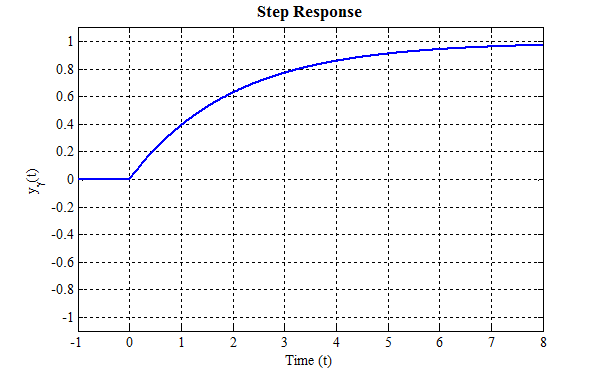
Step 2 is to differentiate the unit step response. However, there is a slight difficulty here because we have a piecewise description of the step response (i.e., there are two pieces, before t=0, and after). We need a functional description of the system if we are to differentiate it for all values of time. Since the function is zero for negative times, we used the unit step function to represent the signal.

We can now take the derivative of this (using the product rule):

We can take the derivative of the first term and use the fact that the derivative of the step function is the impulse function to rewrite the second.

The rightmost term can be simplified. SInce δ(t) is zero except when t=0, we can write a general rules

so

Recall that the number multiplying the unit impulse is the area of the resulting (scaled) impulse, so this represents an impulse with area=0. Such an impulse has no effect on system behavior, so we can drop this term and we get:

This result is shown below.

As a second example, consider the systems shown below in which we have swapped the components from the fires example. Find the unit impulse response of the sytstems.

Solution:
Step 1 is
to find the unit step response of the system (derived elsewhere)

with time constants as before.

Step 2 is to differentiate the unit step response. However, there is a slight difficulty here because we have a piecewise description of the step response (i.e., there are two pieces, before t=0, and after). We need a functional description of the system if we are to differentiate it for all values of time. Since the function is zero for negative times, we used the unit step function to represent the signal.

We can now take the derivative of this (using the product rule):
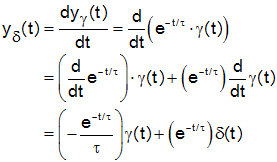
The rightmost term can be simplified.

In this case the impulse response has an impulse function:

This result is shown below.
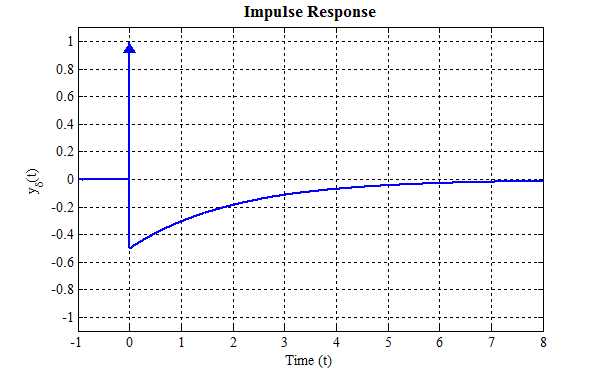
The impulse function in the result is easily understood. Because the step response has a discontinuity in it (i.e., a step), and the impulse response is simply the derivative of the step response, this causes an impulse function as part of the impulse response.
If the step response of a system has no discontinuities, the impulse response has no impulse functions.
If the step response of a system has a discontinuity, the impulse response will have an impulse function as a part of it at the same time as the discontinuity.
The system below
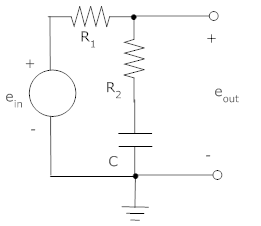
has a step response given by (derivation here - derivation assumes knowledge of Laplace Transforms)
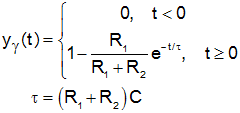
Find the impulse response.
Solution:
Put in functional form and
differentiate:
As expected, since the step response has a discontinuity, the impulse response has an impulse function as part of it.
The differential equation

represents a second order critically damped system that has a step response given by (derivation here - derivation uses Laplace Transforms)

Find the impulse response.
Solution:
Put in functional form and
differentiate (note, in the interest of brevity not all steps are in the
differentiation are given):
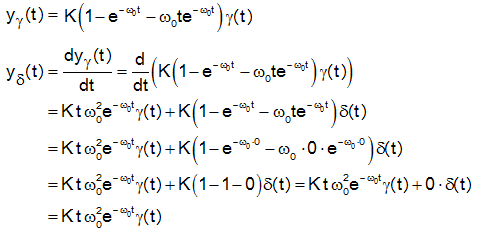
In the last step we used the fact that an impulse of zero area has no effect on the response. As expected, the result has no impulse function in it because there was no discontinuity in the step response
The impulse response of a system is important because the response of a system to any arbitrary input can calculated from the system impulse response using a convolution integral. Details are discussed here.